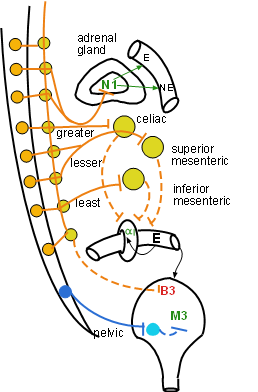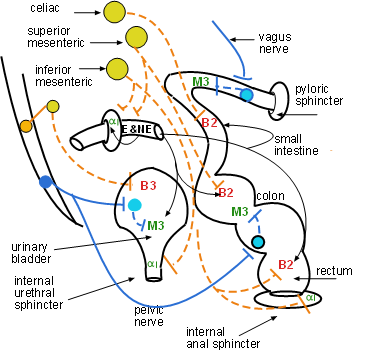
"Splanchnic" means having to do with the viscera (i.e., internal organs). Sympathetic preganglionic axons (orange lines) emerge from the cord and pass through ganglia of the sympathetic chain (line of yellow circles) without synapsing. They gather into three nerves called the greater, lesser & least splanchnic nerves. Though not obvious in the diagram the greater consists of bilateral outflow from T5-9, the lesser of outflow from T 10 & 11 and the least from T 12.
Parasympathetic preganglionic axons (blue line) emerge from the sacral region of the cord to form the pelvic splanchnic nerve. These neurons penetrate pelvic organs to synapse with intramural ganglia light blue circle. From here, postganglionic axons (dashed blue line) synapse with their receptors within the organ.
These ganglia (large yellow circles) are named the celiac, superior mesenteric and inferior mesenteric. They sit just ventral to the aorta and the nerves entering and leaving them are intertwined forming a plexus. This entire region is called the 'solar plexus'. Within these ganglia preganglionic neurons acetylcholine on nicotinic 1 (not shown) receptors on cell bodies of postganglionic neurons. These neurons respond by sending impulses down their axons to release norepinephrine on the organs they innervate. An example is the innervation of an abdominal vessel in the diagram to the right.
The adrenal medulla is unique because it is the only organ directly innervated by preganglionic (orange line), instead of postganglionic, neurons. These preganglionic neurons (orange lines) form a branch of the greater splanchnic nerve as indicated in the diagram. Acetylcholine activation of nicotinic 1 (N1) receptors of chromaffin cells in the medulla increases their secretion of epinephrine (80%) and norepinephrine (20%) into capillaries. It is this release of epinephrine that is a hallmark of the "fight-or-flight response" resulting from excessive sympathetic stimulation.
This organ system contains a nervous system of its own called the enteric (i.e., intestinal) nervous system; some classify this as a third division of the autonomic nervous system.

The vagus nerve contains parasympathetic preganglionic neurons (blue lines) that penetrate the stomach wall to synapse within a plexus of postganglionic cell bodies (light blue circle). This plexus (myenteric/Auerbach's) lies between the outer longitudinal and inner circular smooth muscle layers (not shown) of the stomach wall. When stimulated by acetylcholine from the preganglionic neurons, the postganglionic neurons also secrete acetylcholine that activates muscarinic 3 (M3) receptors on smooth muscle of both muscle layers. The result is increased motility of the stomach.
Another plexus lies between the circular smooth muscle layer and the mucosa. The axons of these parasympathetic postganglionic neurons connect with mucosal gastric glands that bear muscarinic 1 (M1) receptors. Acetylcholine activated M1 receptors cause an increase in gastric juice secretion.
The celiac ganglion (top yellow circle) houses the cell bodies of sympathetic postganglionic neurons whose axons (dashed orange lines) lead to beta 2 receptors of both muscle layers of the stomach wall. Norepinephrine activated beta 2 receptors cause decreased motility of the stomach wall. Other neurons innervate the pyloric sphincter releasing norepinephrine onto the alpha 1 receptors located on these smooth muscle cells. When activated by NE they respond by increasing their tone making passage of material from the stomach to the intestine more difficult. Note that there are no sympathetic postganglionic neurons innervating the gastric glands.

Like the stomach, the proximal small intestine is innervated by branches of the vagus nerve (blue line). Synapses occur within the myenteric plexus(light blue circle). Acetylcholine released from postganglionic neurons (also called enteric neurons) binds with muscarinic 3 (M3) receptors on the intestinal smooth muscle to increase motility.
The remainder of the small intestine has little parasympathetic innervation. However, the colon and rectum do have parasympathetic innervation from the pelvic nerve (blue line). Again, the postganglionic neurons are the enteric neurons of the myenteric plexus. The smooth muscle receptors are muscarinic 3 (M3) and activation by acetylcholine increases motility in these sections.
The small intestine is innervated by postganglionic axons (dashed orange line) originating in the celiac ganglion. The colon (large intestine) is innervated by neurons from the superior mesenteric ganglion while in the rectum they originate in the inferior mesenteric ganglion. Norepinephrine is released from these to binds with beta 2 (B2) receptors on the smooth muscle layers to decrease their motility. Additionally, neurons from the inferior mesenteric also innervate the internal anal sphincter and release norepinephrine onto alpha 1 receptors causing increased tone in that tissue.
The sympathetic division controls these arteries. The circular smooth muscle encircling the arteries supplying the gastrointestinal tract have alpha 1 receptors. They are innervated by sympathetic postganglionic neurons (dashed orange lines). There are many splanchnic arteries with innervations originating in all three collateral ganglia. Norepinephrine activated alpha 1 receptors causes the encircling smooth muscle to constrict reducing blood flow to the GI tract. Blood-borne epinephrine (E) has the same effect. There is no parasympathetic innervation.
The preganglionic neurons (blue line) of the pelvic splanchnic nerves innervate the bladder wall. They secrete acetylcholine onto the cell bodies of postganglionic neurons within intramural ganglia (light blue circle) in the wall. Postganglionic axons (dashed blue line) release acetylcholine to activate muscarinic 3 receptors on smooth muscle cells. These cells respond by increasing their tone so that the bladder is not as compliant to filling.
The bladder wall musculature also has beta 3 receptors that are innervated by postganglionic neurons from the hypogastric nerve arising from the ganglionic chain. Activated beta 3 receptors cause decreased muscle tone in the bladder that facilitates filling.
The smooth muscle of the neck of the bladder (internal urethral sphincter) has alpha 1 receptors. Activation by norepinephrine from postganglionic neurons arising from the inferior mesenteric ganglion causes an increase in tone helping to maintain the urine in the expanding bladder.
Last update: 10/6/2103